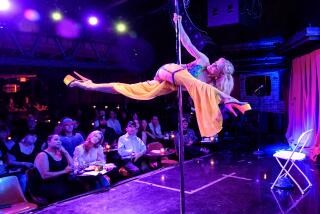NUN GIVES HER GIFT OF DANCE TO CHILDREN
- Share via
Talent knows no economic barriers, says Sister Beth Burns, so she wants to ensure that young people who can’t afford dance lessons have a chance to develop their potential.
Burns, who has been dancing for 20 years, created the Santa Ana-based St. Joseph Ballet Company in 1983 to give young dancers an opportunity to study at nominal cost and “develop talent that would otherwise be wasted.”
The company’s 85 dancers, ages 9 to 19, will give a benefit performance at 7 p.m. Saturday at Santa Ana Valley High School.
Two years ago, Burns--a nun in the religious order of the Sisters of St. Joseph of Orange--taught 40 dancers; last year, she recruited 60. “So we’re growing by leaps and bounds,” she said enthusiastically.
Burns is able--thanks to foundation, corporate and individual support--to offer students introductory, intermediate or advanced ballet classes, two to five times a week, for a nominal fee of $10 a month. That fee also covers practice clothes, toe shoes, costumes and occasional field trips to big-league ballet performances by American Ballet Theatre, the Joffrey Ballet and other groups. The dance company’s budget for the year is about $70,000.
“But if the fee is a difficulty for the family, we waive it, and everything is free,” she said. “About 90% of our kids don’t pay.”
Burns estimated that she has taught more than 300 children since the company was founded. Most of them are beginners, and 85% are minority youths, she said.
“Speaking idealistically, this is an attempt to enrich the lives of young people who live within real limited means, to bring beauty and justice into their lives.
“But there’s no sense of the program being a freebie because it takes so much discipline to come every day.”
“Kids who can’t handle coming to class every day drop out. I push them to do their best, and they work hard and sweat a lot.”
Burns, 30, started studying dance at the age of 10 while living in Portland. She continues to take dance classes regularly in Los Angeles. It was “through the beauty of dance I was led to the love of God and the (life of the) convent,” she said.
She acknowledged that hers is not “a traditional role” for a nun, but that dancing is “not against any one of my vows--chastity, poverty and obedience.”
“When I do an arabesque, I’m not breaking any of my vows,” she said, laughing.
“Basically, I’ve found that dance is the most effective way for me to love young people,” she added. “When we dance, we form a very personal relationship. Something real special happens between me and my dancers.”
Burns focuses her choreography on “what’s happening in my dancers’ lives.”
“I’m real personal,” she said.
For example, Burns described some of the dances on Saturday’s program:
--”For the fun of it” (set to the Amy Grant song “Find a Way”) is about “girls just hanging out and going through different moods and emotions of adolescence,” she said.
--”Emerging” (to three sections of Ravel’s “Le Tombeau de Couperin”) shows “a young woman going through all the stages of trying to dance, and growing up in front of your eyes.”
--”Hope Dances” (music by the classical-rock group Mannheim Steamroller) features “all 85 dancers performing while some of the kids offstage read the poetry they have written about what dance means to them.”
Though positive and optimistic, Burns is no Pollyanna. She insisted that she is giving real ballet lessons and not just letting kids noodle around in dance slippers.
“I think the kids develop very rapidly here,” she said. “I teach real solid technique, mostly based on (the theories of teacher Enrico) Cecchetti. I give lots of personal correction, and I am very worried about correct placement. I constantly harangue them about placement.
“But we’re only 2 1/2 years old, and you don’t make a dancer in two years. Only time will tell.”
Burns said she believes that there is no cultural barrier between her students and the aristocratic dance form of ballet, although “if they’ve only been exposed to videos and pop music and pop dancing, that can dull the senses to the subtlety and refinement of (ballet).
“Also, dance touches a place in the soul of some kids, and in other kids it doesn’t.
“The program allows those who stick with it to grow in self-discipline. Their self-esteem rises because I am extremely affirming and because they gain a sense of accomplishment through performing.”
As the students learn ballet technique, they “become free to express themselves and become more of who they want to be,” Burns said.
“For me, what’s important is the impact this has on one’s life. If dance can’t reach deep into one’s life and touch the soul and enrich a person, I don’t know what the point of it is. This is not art for art’s sake, but art for people’s sake.”
More to Read
The biggest entertainment stories
Get our big stories about Hollywood, film, television, music, arts, culture and more right in your inbox as soon as they publish.
You may occasionally receive promotional content from the Los Angeles Times.










